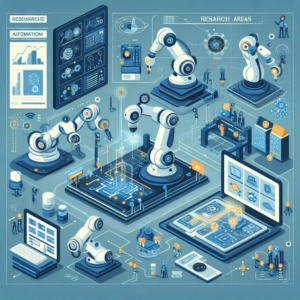Control Systems in Industrial Robotics Explained
Overview of Control Systems in Robotics with Cloud Computing
Control systems in industrial robots are essential for improving functionality and performance. When integrated with cloud computing, they enable advanced automation and smarter decision-making. As robots become more complex, their control systems must also evolve. This requires a deep understanding of control strategies, distributed computing, and sensory data integration. By leveraging artificial intelligence (AI) and cloud platforms, modern robotics can achieve greater efficiency and adaptability.
1. Hierarchical Control Systems for Enhanced Automation
Hierarchical control systems manage robotic operations by dividing tasks into different levels. This structure ensures smooth communication between components, allowing real-time adjustments and efficient command processing.
1.1. Structure of Hierarchical Control
The hierarchical model resembles a tree structure. At the top, a high-level computing module develops strategies based on feedback, often using cloud computing for enhanced analysis. These commands break down into smaller, actionable steps as they pass through different levels.
1.2. Task Decomposition
Breaking complex tasks into smaller steps ensures smoother execution. For example, a movement command is divided into navigation steps, which cloud-based systems can refine for better accuracy. This method allows robots to perform precise actions while maintaining efficiency.
1.3. Real-Time Performance Using Cloud Computing
Real-time control is crucial in dynamic environments. Cloud computing provides scalable processing power, enabling fast decision-making with minimal delays. This ensures that robots respond quickly to changing conditions, improving automation reliability.
2. Distributed Computing in Robot Control with Artificial Intelligence
Distributed computing enhances robotic control by dividing tasks across multiple systems. This approach improves processing efficiency and responsiveness.
2.1. Advantages of Distributed Systems
Cloud computing allows robots to process different tasks simultaneously. For example, one unit can manage motion control while another handles sensory input. This division leads to faster and more efficient robotic operations.
2.2. Challenges in Distributed Computing
Despite its advantages, distributed computing requires standardized communication protocols. AI plays a key role in integrating these systems, ensuring smooth coordination between different units.
2.3. Case Studies
Several companies, including Automatix and the National Bureau of Standards, use distributed computing to enhance robotic performance. Their success highlights the importance of cloud-based computing in streamlining industrial automation.
3. Integration of Sensory Data for Smart Robotics
Integrating sensory data improves a robot’s ability to interact with its environment. Sensors provide valuable information that enables robots to make informed decisions and adjust their actions accordingly.
3.1. Types of Sensors Leveraging Cloud Computing
Industrial robots use a variety of sensors, such as vision and touch sensors. Cloud platforms help process sensor data in real time, improving accuracy and adaptability.
3.2. Feedback Mechanisms Enhanced by AI
Feedback loops enable robots to adjust their movements based on real-time data. For example, vision-based feedback allows robots to modify their trajectory instantly, ensuring precise navigation. AI enhances these systems by improving decision-making capabilities.
3.3. Real-Time Data Processing with Microsoft Azure Cloud Computing
Real-time data processing is essential for interactive robotic behavior. Platforms like Microsoft Azure offer scalable solutions for managing large datasets, ensuring faster response times and greater efficiency.
4. Advances in Control Strategies with AI and Cloud Solutions
New control strategies are emerging to improve precision and flexibility in robotics. AI and cloud computing play a major role in shaping these innovations.
4.1. Nonlinear Control Techniques
Traditional linear controllers may not always work well in dynamic environments. Nonlinear control methods allow robots to adapt more effectively, often using cloud-based computing resources to fine-tune operations.
4.2. Adaptive Control Systems
Adaptive control systems adjust to environmental changes, making them ideal for unpredictable settings. Cloud computing helps analyze data and update control parameters in real time, ensuring smooth operations.
4.3. Learning-Based Control Through AI
Machine learning is transforming control systems by allowing robots to improve their performance over time. By analyzing past experiences, AI-driven control systems optimize robotic efficiency and adaptability.
5. Future Directions in Control Systems Research
Ongoing research continues to refine robotic control systems. Several key areas will shape the future of industrial automation.
5.1. Enhanced Sensory Integration
Advanced sensors will enable robots to develop a more detailed understanding of their surroundings. Cloud computing will support real-time processing, improving decision-making capabilities.
5.2. Collaborative Robotics
Collaborative robots, or cobots, are designed to work alongside humans. Future control systems will focus on improving safety and communication, ensuring seamless interaction between robots and workers.
5.3. Standardization of Control Interfaces
To improve compatibility across industries, standardized control interfaces will be crucial. This will promote greater adoption of robotics solutions in manufacturing, logistics, and healthcare.
Conclusion
Control systems are the backbone of industrial robotics, enabling precision and adaptability in automated processes. The integration of cloud computing and artificial intelligence enhances these systems, making robots smarter and more efficient. By utilizing hierarchical control architectures, distributed computing frameworks, and advanced sensory integration, robotic systems can perform complex tasks with ease.
Looking ahead, research into Programming Environments Evolution will further improve how robots interact with their surroundings. Advances in nonlinear and adaptive control strategies will lead to even greater levels of automation. As cloud solutions and AI-driven learning models continue to evolve, industrial robotics will become more intelligent, efficient, and capable of handling diverse tasks in modern industries.
Do you like to read more educational content? Read our blogs at Cloudastra Technologies or contact us for business enquiry at Cloudastra Contact Us.
